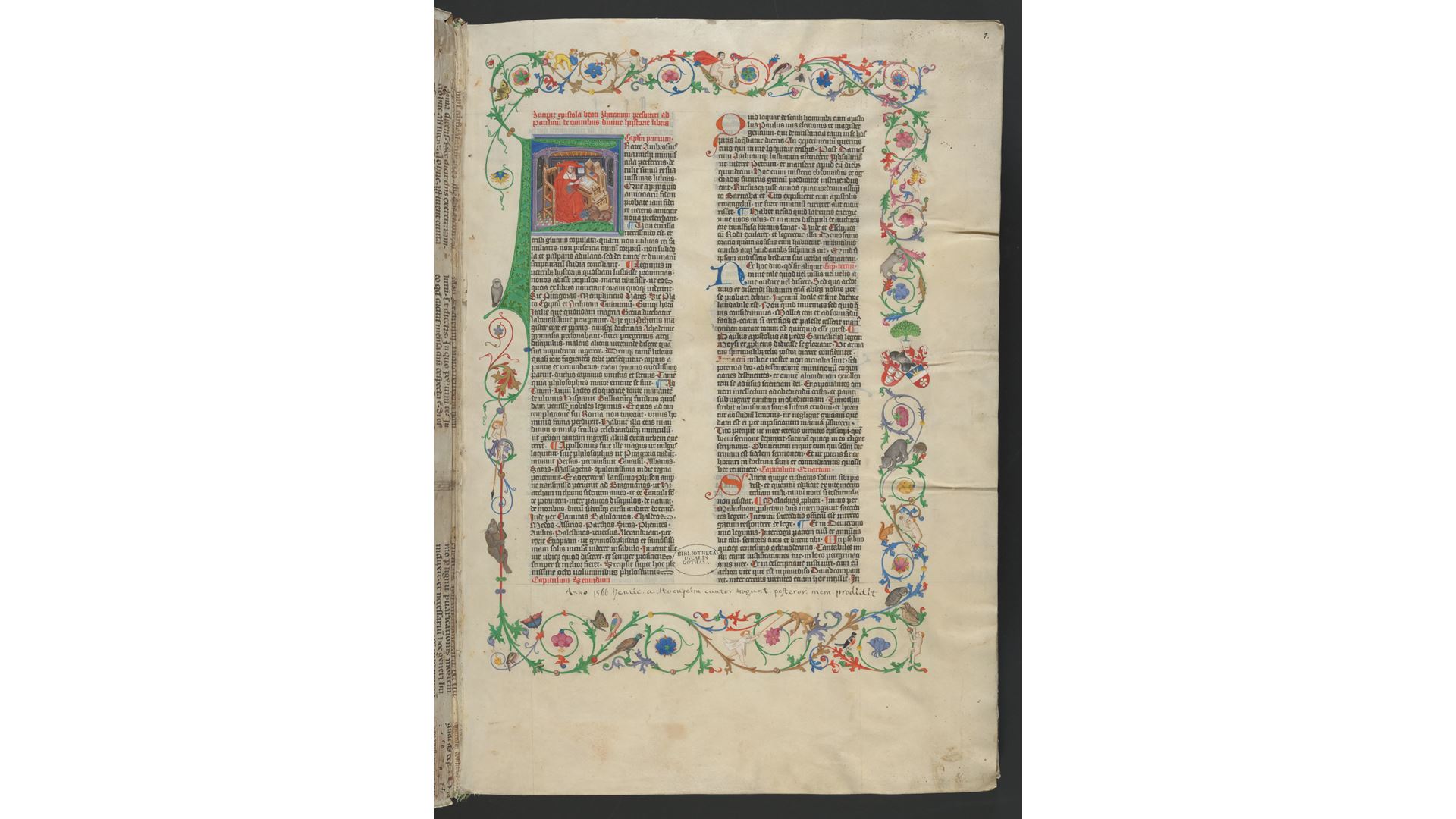- The Giant Bible is famous for having been copied by a single scribe, who precisely dated his progress between April 4, 1452, and July 9, 1453
- New scholarship points to Mainz as the place of origin for both the Giant Bible and the Gutenberg Bible
- In its digital form, the Giant Bible of Mainz can now be accessed by people across the globe and will be preserved for future generations
The Giant Bible of Mainz Digitized by the Library of Congress
A virtual event with international scholars will present new research about one of the last handwritten giant bibles in Europe
The Giant Bible of Mainz, one of the last handwritten giant bibles in Europe, has now been digitized by the Library of Congress, ensuring online access to an important national treasure from the 15th century. The Rare Book and Special Collections Division will hold a virtual event with international scholars on Oct. 6 to present new research about the origins of one of the Library’s great treasures.
The Giant Bible is famous for having been copied by a single scribe, who precisely dated his progress between April 4, 1452, and July 9, 1453. These dates are remarkable because they place the creation of this manuscript bible in proximity to the first printed bible crafted in Europe, the Gutenberg Bible.
While it has never been in question that the Giant Bible and the Gutenberg Bible were created around the same time, scholars were previously less certain about the location of Mainz, Germany, as the birthplace of both bibles. The Giant Bible of Mainz received its name from an inscription on the first leaf of the manuscript, which states that in 1566, Heinrich Stockheim, cantor at the Mainz Cathedral, signed the bible over to the cathedral’s custody. This early evidence of the bible’s presence in Mainz, coupled with the stylistic influence of the Middle Rhine upon certain aspects of its paintings and illuminations, suggested Mainz as a place of origin. But it left room for doubt.
New scholarship is putting those doubts to rest. As panelists will discuss during the Oct. 6 event, historian John Jefferson recently identified the coat-of-arms on the first leaf of the manuscript as those of Bishop Rudolph von Rüdesheim and Abbot Emmerich Nauta of Winkel, both of whom were local to the Mainz area when the Giant Bible was being copied. This identification makes it much more likely that the Giant Bible was created within the greater Mainz area, and brings it within greater historical proximity to the beginning of European printing.
In its digital form, the Giant Bible of Mainz can now be accessed by people across the globe and will be preserved for future generations. In keeping with Rosenwald’s commitment to encouraging broad cultural engagement with the history of the illustrated book, these images allow anyone interested in medieval manuscripts to encounter each page of this singular codex.
“Digitization is an important part of equitable access to early materials, and we are excited that new voices will have an opportunity to become part of the future of the Giant Bible at the Library of Congress,” said Marianna Stell, reference librarian in the Rare Book and Special Collections Division.
On Oct. 6, National German-American Friendship Day, the Library of Congress will host an online event with an international panel of scholars, “Opening the Case: The Giant Bible of Mainz at the Library of Congress”, from 11:00 am to 12:30 pm EST. The virtual event will present new research about the context and significance of the Giant Bible of Mainz, acquired by the Library in 1952 from philanthropist and bibliophile Lessing J. Rosenwald as part of the Rosenwald Collection.
Panel participants will include: Paul Needham, Scheide librarian emeritus at Princeton University; Eric White, Scheide librarian at Princeton University; Christoph Winterer, research associate at DFG Manuscript Project at the Scientific City Library of Mainz; John Jefferson, independent scholar of late medieval history, adjunct professor at the Akademia Ignatianum in Krakow, Poland; Marianna Stell, reference librarian in the Library’s Rare Book and Special Collections Division, and Stephanie Stillo, acting assistant chief, Rare Book and Special Collections Division.
Later in the evening, the Library will also provide a public viewing of the Giant Bible in the Great Hall from 5:00 pm to 7:00 pm EST. This in-person viewing is free, but tickets are required. You can reserve a ticket at Live! at The Library: The Giant Bible of Mainz or on the Library’s Events Page.
The Rare Book and Special Collections Division houses close to 800,000 books encompassing nearly all eras and subjects maintained in well over 100 separate collections, including the Rosenwald Collection. The Division has a particular collecting strength in 15th-century printed books.
The Library of Congress is the world’s largest library, offering access to the creative record of the United States — and extensive materials from around the world. It is the main research arm of the U.S. Congress and the home of the U.S. Copyright Office. Explore collections, reference services and other programs and plan a visit atloc.gov; access the official site for U.S. federal legislative information atcongress.gov; and register creative works of authorship atcopyright.gov.
###
Media Contact: María Peña, mpena@loc.gov
Public Contact: Marianna Stell, marstell@loc.gov
PR 22-086
09/29//22
ISSN 0731-3527

